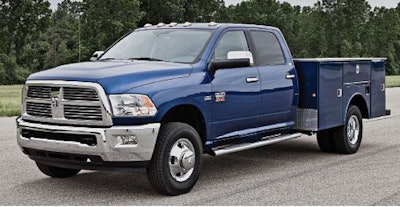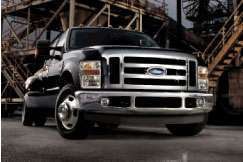Pickup lines
You may have heavy payloads, but do you really need a diesel and a 4.10:1 rear axle ratio? Maybe not
Pickup truck buyers tend to fall into one of two camps: Weekend warriors who haul little more than the occasional load of mulch from the local garden center, or serious commercial buyers who are more likely to demand the utility that supports a load-hauling trade. The choice of a true “work” truck should begin with a careful look at the jobs ahead.
 For 2012, Ram Trucks beefed up trailer towing capacity for its 3500 pickups, now towing 22.700 pounds maximum.
For 2012, Ram Trucks beefed up trailer towing capacity for its 3500 pickups, now towing 22.700 pounds maximum.Few factors have a bigger impact on the preferred specs than the trailer hitch. “In the pickup side of the commercial business, roughly 90 percent of these customers tow,” says Brian Rathsburg, marketing manager for Ford’s F-Series Super Duty trucks. But there is a big difference in pickups needed to tow either 10,000 or 20,000 pounds.
Weight always should be an important factor in the choices between one model and the next, Rathsburg says. “Then you can back into what the gross vehicle weight of the truck is, and from there you can back into what the specific configuration is,” he says.
While heavier weights tend to lead buyers to a diesel engine for its low-end torque, its gasoline counterpart often may make more economic sense – even in a commercial setting. Those who plan to trade in their trucks every three years, or haul only the occasional heavy load, may not need a diesel power plant.
“It’s hard to make that extra expense up just in fuel economy savings unless they put on a lot of miles,” says Dan Tigges, General Motors’ product manager for full-size trucks, which include the Silverado and Sierra. “From a performance standpoint, you’re not going to see a whole lot of difference.”
 Ford’s F-Series Super Duty trucks use a monobeam front suspension for improved handling and durability.
Ford’s F-Series Super Duty trucks use a monobeam front suspension for improved handling and durability.Many truck families will haul the same payload with a gasoline or diesel engine, says Alan Costantino, product development engineer for Ford’s F-Series Super Duty trucks. The diesel engine will just do it more efficiently, and its benefits don’t end there: The latest models also have borrowed a tool from heavier vehicle classes, introducing exhaust brakes that harness the stopping power of backpressure. “It’ll give you a lot more brake life and makes the truck a lot easier to drive,” Tigges says.
Getting torqued
Engine comparisons also should look well beyond horsepower numbers, which play their biggest roles when cruising down the highway. It’s the twisting power of torque that will get everything moving in the first place.
A careful look at an engine’s related torque curves – graphs that show the relationship between torque and engine speed – show exactly when this power can be expected. The flatter the torque curve, the more constant the performance will be at different engine speeds. “You’re always going to want to see the torque come in at as low an RPM as possible, because that’s going to help you in the launch of the vehicle,” Tigges says.
Rear axle ratios also play a key role in towing capacity. Those who tow up steep hills or make lots of stops and starts during a typical workday likely will be drawn to a 4.10:1 rather than a traditional 3.73:1, Tigges says; this will keep the engine from lugging when hauling a heavy load and can improve fuel economy.
But long-term users of pickups may focus more attention on this factor than it deserves. “As we got better low-end torque and better transmissions, we don’t need that much of a final drive ratio anymore,” says John Stramotas, product manager for Toyota’s Tundra and Sequoia.
Ford’s F-250 and F-350 are offered with ratios as low as 3.31:1, helping to improve fuel economy during average trips. Combined with a diesel engine and a gross combined weight rating of 23,500 pounds, an F-250 with this ratio still can tow up to 12,500 pounds. A similarly spec’d F-450 can haul a hefty 17,500 pounds.
Weighty matters
Truck choices need to consider the weight of everything to be moved, whether it is carried in the trailer, the truck bed or the cab; that’s why buyers should focus on published payloads rather than gross vehicle weight ratings. A truck that seems to offer a heavier GVWR may be heavier than its counterpart, leaving less weight for payloads.
“When you add that extra weight, it’s going to cost you in fuel economy,” Tigges says. Expect a higher purchase price as well: “All that steel doesn’t come free.”
No matter what the load includes, the truck’s handling characteristics will rely on the suspension, and while packs of leaf springs will carry the loads at the rear, there can be some significant differences upfront. GM has opted for an independent front suspension with the goal of improving the ride and keeping wheels perpendicular to the road. Ford uses a monobeam front suspension, arguing that it offers better durability.
“While there may be some ride [or] comfort tradeoff, the peace of mind our customer gets outweighs that,” Rathsburg says. Ford has offset the added weight elsewhere in the truck design, he says.
Any model of truck will return a stiffer ride if the buyer opts for a heavy-duty payload package and its stiffer rear springs, but Constantino says better-tuned shock absorbers, bushings and dampers all have made a difference in recent years.
Those who spec a heavier tow package for the most demanding trucks also will get more than a hitch and a 4.10:1 final drive, Stramotas says. The features likely will include seven- or four-pin connectors, trailer brake controllers and a larger radiator and transmission oil cooler to control temperatures.













